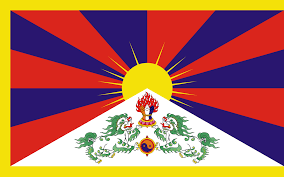Language/Tibetan/Vocabulary/Animals
Hi Tibetan learners! 😊
In this lesson, we will learn about animals in Tibetan. As you may already know, Tibetan culture is closely intertwined with nature. Tibetan people practice Buddhism, and for them, every living being is equal and should be treated with respect. This way of thinking reflects on the Tibetan language, where we have dozens of words related to animals. Let's explore some common animals and their names in Tibetan!
Don't hesitate to look into these other pages after completing this lesson: Education, Drinks, Questions & Health.
Domestic Animals[edit | edit source]
Let's start with domestic animals, animals that you might find in a Tibetan family. Here are some of the most common ones:
| Tibetan | Pronunciation | English |
|---|---|---|
| བོད་ཁྱི་ཁྲི་མཐའ་ | bod kyi khri mtha | horse |
| ང་ན་ | nga na | cow |
| རྡ་རྗེ་ | rda rje | yak |
| ཡུ་དྲུག་ | yu drug | sheep |
| དགོང་དུ་ | dgong du | goat |
| མཁོ་ལོ་ | mKho lo | donkey |
| རིག་གནས་ | rig gnas | chicken |
| ཟ་ཁྲའི་ཕྲག་ | za khra'i phrag | duck |
Let's see some examples of how to use these words:
- Person 1: ང་ན་དཔེ་ཆ་གོང་བ་བདག་གིས་་ (nga na dphe cha gong ba bdag gi s)
(I woke up early to milk the cow today) - Person 2: རིག་གནས་པའི་མཁོས་ལོས་བྱེད་པ་(rig gnas pa'i mkhos los byed pa)
(I am learning how to cook a chicken)
Wild Animals[edit | edit source]
Now, let's venture out into the wild and learn the names of some Tibetan wild animals!
| Tibetan | Pronunciation | English |
|---|---|---|
| སེ་རི་ | se ri | deer |
| རྫོང་ | rdzong | antelope |
| གློ་བཟོ་ | glo bzo | rabbit |
| བཟོ་བ་ | bzo ba | hare |
| ཤེས་པའི་འཁོར་ལོ་ | shes pa'i 'khor lo | squirrel |
| ལྦྲོབ་པོ་ | lbrod po | fox |
| ཁྲོ་སིའི་ཁུ་རུ་སུམ་ཅུ་རྟགས་པ་ | khro si'i khu ru sum cu rtags pa | three-legged crow |
Let's use these words in a dialogue:
- Person 1: སེ་རི་ཐེ་བརྟན་དང་ལྷ་ག་ཡོད་པའི་དཔྱད་འཛིན་ལ་ཚོགས་པ་ (se ri then bten dang lha ga yod pa'i dpyad 'dzin la tshogs pa)
(The deer is regarded as a lucky animal in Tibetan culture, and we offer it white food and incense in religious events) - Person 2: ཁྱད་པར་མྱ་ངན་གླེང་འགྲོ་བྱེད་པ་(khyad par mya ngan gleng 'gro byed pa)
(Last weekend I went hunting for antelope near the mountains)
Insects and Reptiles[edit | edit source]
Let's not forget about small creatures. Here are some words related to insects and reptiles:
| Tibetan | Pronunciation | English |
|---|---|---|
| ཀུན་བུའི་གུས་པ་ | kun bu'i gus pa | spider |
| ངག་པོ་ | ngag po | mosquito |
| སྣོ་ | sno | fly |
| དཀོན་པོ་ | dkon po | bee |
| མྱ་རྒྱ་ | mya rgya | snake |
| བུ་འབྱུང་ | bu 'byung | frog |
Let's try to create a dialogue with these words:
- Person 1: ངག་པོའི་གྲངས་པ་གླུ་སྒྲུབ་པ་(ngag po'i grangs pa glu sgrub pa)
(We need to get rid of the mosquito's nest in the yard) - Person 2: དཀོན་པོ་རྒྱ་ཆེ་ལུ་ཆུ་བཞིན་པ་(dkon po rgya che lu chu zhin pa)
(The bee is drinking nectar from the flowers)
By learning these animal names, you not only enhance your Tibetan vocabulary but also get to appreciate the close relationship between Tibetan people and nature. If you want to learn more Tibetan vocabulary, check out the Vocabulary page. You can also join native speakers and ask them any questions you have about the language!
➡ If you have any questions, please ask them in the comments section below.
➡ Feel free to edit this wiki page if you think it can be improved. 😎
Videos[edit | edit source]
Animal Name And Sound For Tibetan Kids - YouTube[edit | edit source]
Tibetan names of some Animals and Birds - YouTube[edit | edit source]
ལོ་རྟགས།(lo rtags): The 12 animal signs used in Tibetan calendar ...[edit | edit source]
Learning Animals Names for kids in Tibetan ( 2 ) སེམས་ཅན་རིགས ...[edit | edit source]
Other Lessons[edit | edit source]
- Geography
- Education
- Time
- Express Surprise
- Food
- Drinks
- How to Say Hello and Greetings
- Colors
- Fruits
- Health
Sources[edit | edit source]

